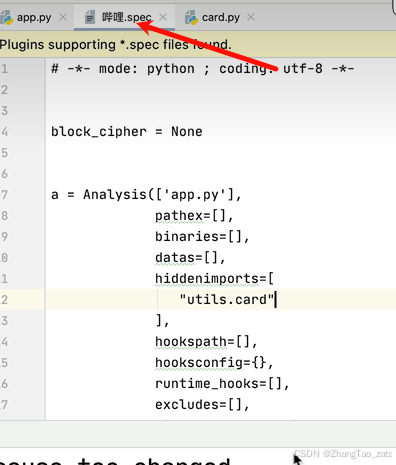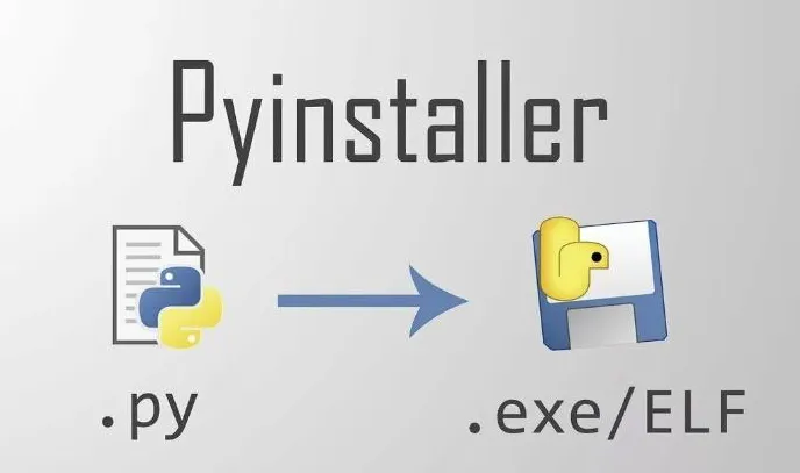一些问题的提醒
打包时候指定了附加文件,但是打包之后附加文件是放在了__internal文件夹里面的
我的解决方法是:
- 使用python代码打包,然后打包好了之后在把文件移动到和exe一个目录
开发的时候引用脚本没有任何问题,但是打包的时候就出错?
我的解决方法是:
- 最好以程序的入口文件位置作为所有脚本的位置
- 最好使用相对路径:我使用的是
Root_dir = os.path.dirname(os.path.realpath(sys.argv[0]))作为我所有函数识别的根路径
其他打包工具
- cx_Freeze:老牌打包工具,稳定可靠
- Auto-py-to-exe:PyInstaller的GUI版本,适合新手使用
- Py2exe:仅支持Windows平台的经典工具
- PyStand: 非常容易快捷的打包方式,只需要把源码和环境拖入制定文件夹就可以
2. 使用PyInstaller进行打包简单使用
pip install pyinstaller
# 最简单的打包
pyinstaller your_script.py
这将生成一个dist文件夹,其中包含可执行文件及其依赖。
也可以使用pyi-makespec命令生成一个.spec文件,然后在.spec文件中进行配置,最后使用pyinstaller命令进行打包。 例如:
pyi-makespec your_script.py然后在生成的.spec文件中进行配置
常用参数说明
PyInstaller提供了多个有用的参数:
基本命令格式:
pyinstaller [options] script.py
- 基础参数:
-F, --onefile # 打包成一个单独的可执行文件
-D, --onedir # 打包成一个文件夹(默认选项)
-n NAME # 指定生成的可执行文件名
-w, --windowed # Windows系统下不显示命令行窗口
-c, --console # 显示命令行窗口(默认)
--noconfirm # 跳过确认提示,直接覆盖现有文件
- 路径和文件相关:
--distpath DIR # 指定打包后的输出路径
--workpath DIR # 指定工作目录路径
--specpath DIR # 指定spec文件的生成路径
-p DIR # 添加Python路径(可多次使用)
--add-data # 添加额外的数据文件
# 格式: source:dest (Windows用;分隔,Linux用:分隔)
--add-binary # 添加额外的二进制文件
- 打包控制:
--hidden-import # 添加隐式导入的模块
--additional-hooks-dir # 指定额外的hooks目录
--runtime-hook # 指定运行时hook脚本
--exclude-module # 排除指定模块
--clean # 清理打包前的临时文件
常见实例:
- 最简单的单文件打包(不需确认):
pyinstaller --noconfirm -F main.py
- 打包成单文件且不显示控制台:
pyinstaller --noconfirm -F -w main.py
- 包含数据文件的打包:
# Windows
pyinstaller --noconfirm -F --add-data "resources;resources" main.py
# Linux/MacOS
pyinstaller --noconfirm -F --add-data "resources:resources" main.py
- 完整的生产环境打包示例:
pyinstaller --noconfirm --onefile --windowed --icon "app.ico" ^
--hidden-import "PIL" ^
--add-data "resources;resources" ^
--add-data "config.yml;." ^
--name "MyApp" ^
main.py
配置文件说明
此外,.spec这个文件提供了可以手动写隐式导入配置的功能,在配置文件中的hiddenimports中写入,然后允许pyinstaller手动选择相关.spec文件,后面不用再接其他配置
pyinstaller -F 哔哩.spec

下面是我用于打包gradio项目的gradio源码和一个配置文件的示例,
# gradio_app.py
import gradio as gr
def greet(name):
return "Hello " + name + "!!"
demo = gr.Interface(fn=greet, inputs="text", outputs="text")
if __name__ == "__main__":
demo.launch()
配置文件
生成方式:
pyi-makespec --collect-all aiofiles --collect-all annotated_types --collect-all anyio --collect-all certifi --collect-all charset_normalizer --collect-all click --collect-all colorama --collect-all dateutil --collect-all fastapi --collect-all ffmpy --collect-all filelock --collect-all fsspec --collect-all gradio --collect-all gradio_client --collect-all groovy --collect-all h11 --collect-all httpcore --collect-all httpx --collect-all huggingface_hub --collect-all idna --collect-all jinja2 --collect-all lxml --collect-all markdown_it --collect-all markupsafe --collect-all mdurl --collect-all multipart --collect-all numpy --collect-all opencc --collect-all orjson --collect-all packaging --collect-all pandas --collect-all pillow --collect-all pip --collect-all pydantic --collect-all pydantic_core --collect-all pydub --collect-all pygments --collect-all python_multipart --collect-all pytz --collect-all requests --collect-all rich --collect-all ruff --collect-all safehttpx --collect-all semantic_version --collect-all setuptools --collect-all shellingham --collect-all sniffio --collect-all starlette --collect-all tomlkit --collect-all tqdm --collect-all typer --collect-all tzdata --collect-all urllib3 --collect-all uvicorn --collect-all websockets --collect-all wheel gradio_app.py
下面是生成得到的配置文件
# gradio_app.spec
# -*- mode: python ; coding: utf-8 -*-
from PyInstaller.utils.hooks import collect_all
datas = []
binaries = []
hiddenimports = []
tmp_ret = collect_all('aiofiles')
datas += tmp_ret[0]; binaries += tmp_ret[1]; hiddenimports += tmp_ret[2]
tmp_ret = collect_all('annotated_types')
datas += tmp_ret[0]; binaries += tmp_ret[1]; hiddenimports += tmp_ret[2]
tmp_ret = collect_all('anyio')
datas += tmp_ret[0]; binaries += tmp_ret[1]; hiddenimports += tmp_ret[2]
tmp_ret = collect_all('certifi')
datas += tmp_ret[0]; binaries += tmp_ret[1]; hiddenimports += tmp_ret[2]
tmp_ret = collect_all('charset_normalizer')
datas += tmp_ret[0]; binaries += tmp_ret[1]; hiddenimports += tmp_ret[2]
tmp_ret = collect_all('click')
datas += tmp_ret[0]; binaries += tmp_ret[1]; hiddenimports += tmp_ret[2]
tmp_ret = collect_all('colorama')
datas += tmp_ret[0]; binaries += tmp_ret[1]; hiddenimports += tmp_ret[2]
tmp_ret = collect_all('dateutil')
datas += tmp_ret[0]; binaries += tmp_ret[1]; hiddenimports += tmp_ret[2]
tmp_ret = collect_all('fastapi')
datas += tmp_ret[0]; binaries += tmp_ret[1]; hiddenimports += tmp_ret[2]
tmp_ret = collect_all('ffmpy')
datas += tmp_ret[0]; binaries += tmp_ret[1]; hiddenimports += tmp_ret[2]
tmp_ret = collect_all('filelock')
datas += tmp_ret[0]; binaries += tmp_ret[1]; hiddenimports += tmp_ret[2]
tmp_ret = collect_all('fsspec')
datas += tmp_ret[0]; binaries += tmp_ret[1]; hiddenimports += tmp_ret[2]
tmp_ret = collect_all('gradio')
datas += tmp_ret[0]; binaries += tmp_ret[1]; hiddenimports += tmp_ret[2]
tmp_ret = collect_all('gradio_client')
datas += tmp_ret[0]; binaries += tmp_ret[1]; hiddenimports += tmp_ret[2]
tmp_ret = collect_all('groovy')
datas += tmp_ret[0]; binaries += tmp_ret[1]; hiddenimports += tmp_ret[2]
tmp_ret = collect_all('h11')
datas += tmp_ret[0]; binaries += tmp_ret[1]; hiddenimports += tmp_ret[2]
tmp_ret = collect_all('httpcore')
datas += tmp_ret[0]; binaries += tmp_ret[1]; hiddenimports += tmp_ret[2]
tmp_ret = collect_all('httpx')
datas += tmp_ret[0]; binaries += tmp_ret[1]; hiddenimports += tmp_ret[2]
tmp_ret = collect_all('huggingface_hub')
datas += tmp_ret[0]; binaries += tmp_ret[1]; hiddenimports += tmp_ret[2]
tmp_ret = collect_all('idna')
datas += tmp_ret[0]; binaries += tmp_ret[1]; hiddenimports += tmp_ret[2]
tmp_ret = collect_all('jinja2')
datas += tmp_ret[0]; binaries += tmp_ret[1]; hiddenimports += tmp_ret[2]
tmp_ret = collect_all('lxml')
datas += tmp_ret[0]; binaries += tmp_ret[1]; hiddenimports += tmp_ret[2]
tmp_ret = collect_all('markdown_it')
datas += tmp_ret[0]; binaries += tmp_ret[1]; hiddenimports += tmp_ret[2]
tmp_ret = collect_all('markupsafe')
datas += tmp_ret[0]; binaries += tmp_ret[1]; hiddenimports += tmp_ret[2]
tmp_ret = collect_all('mdurl')
datas += tmp_ret[0]; binaries += tmp_ret[1]; hiddenimports += tmp_ret[2]
tmp_ret = collect_all('multipart')
datas += tmp_ret[0]; binaries += tmp_ret[1]; hiddenimports += tmp_ret[2]
tmp_ret = collect_all('numpy')
datas += tmp_ret[0]; binaries += tmp_ret[1]; hiddenimports += tmp_ret[2]
tmp_ret = collect_all('opencc')
datas += tmp_ret[0]; binaries += tmp_ret[1]; hiddenimports += tmp_ret[2]
tmp_ret = collect_all('orjson')
datas += tmp_ret[0]; binaries += tmp_ret[1]; hiddenimports += tmp_ret[2]
tmp_ret = collect_all('packaging')
datas += tmp_ret[0]; binaries += tmp_ret[1]; hiddenimports += tmp_ret[2]
tmp_ret = collect_all('pandas')
datas += tmp_ret[0]; binaries += tmp_ret[1]; hiddenimports += tmp_ret[2]
tmp_ret = collect_all('pillow')
datas += tmp_ret[0]; binaries += tmp_ret[1]; hiddenimports += tmp_ret[2]
tmp_ret = collect_all('pip')
datas += tmp_ret[0]; binaries += tmp_ret[1]; hiddenimports += tmp_ret[2]
tmp_ret = collect_all('pydantic')
datas += tmp_ret[0]; binaries += tmp_ret[1]; hiddenimports += tmp_ret[2]
tmp_ret = collect_all('pydantic_core')
datas += tmp_ret[0]; binaries += tmp_ret[1]; hiddenimports += tmp_ret[2]
tmp_ret = collect_all('pydub')
datas += tmp_ret[0]; binaries += tmp_ret[1]; hiddenimports += tmp_ret[2]
tmp_ret = collect_all('pygments')
datas += tmp_ret[0]; binaries += tmp_ret[1]; hiddenimports += tmp_ret[2]
tmp_ret = collect_all('python_multipart')
datas += tmp_ret[0]; binaries += tmp_ret[1]; hiddenimports += tmp_ret[2]
tmp_ret = collect_all('pytz')
datas += tmp_ret[0]; binaries += tmp_ret[1]; hiddenimports += tmp_ret[2]
tmp_ret = collect_all('requests')
datas += tmp_ret[0]; binaries += tmp_ret[1]; hiddenimports += tmp_ret[2]
tmp_ret = collect_all('rich')
datas += tmp_ret[0]; binaries += tmp_ret[1]; hiddenimports += tmp_ret[2]
tmp_ret = collect_all('ruff')
datas += tmp_ret[0]; binaries += tmp_ret[1]; hiddenimports += tmp_ret[2]
tmp_ret = collect_all('safehttpx')
datas += tmp_ret[0]; binaries += tmp_ret[1]; hiddenimports += tmp_ret[2]
tmp_ret = collect_all('semantic_version')
datas += tmp_ret[0]; binaries += tmp_ret[1]; hiddenimports += tmp_ret[2]
tmp_ret = collect_all('setuptools')
datas += tmp_ret[0]; binaries += tmp_ret[1]; hiddenimports += tmp_ret[2]
tmp_ret = collect_all('shellingham')
datas += tmp_ret[0]; binaries += tmp_ret[1]; hiddenimports += tmp_ret[2]
tmp_ret = collect_all('sniffio')
datas += tmp_ret[0]; binaries += tmp_ret[1]; hiddenimports += tmp_ret[2]
tmp_ret = collect_all('starlette')
datas += tmp_ret[0]; binaries += tmp_ret[1]; hiddenimports += tmp_ret[2]
tmp_ret = collect_all('tomlkit')
datas += tmp_ret[0]; binaries += tmp_ret[1]; hiddenimports += tmp_ret[2]
tmp_ret = collect_all('tqdm')
datas += tmp_ret[0]; binaries += tmp_ret[1]; hiddenimports += tmp_ret[2]
tmp_ret = collect_all('typer')
datas += tmp_ret[0]; binaries += tmp_ret[1]; hiddenimports += tmp_ret[2]
tmp_ret = collect_all('tzdata')
datas += tmp_ret[0]; binaries += tmp_ret[1]; hiddenimports += tmp_ret[2]
tmp_ret = collect_all('urllib3')
datas += tmp_ret[0]; binaries += tmp_ret[1]; hiddenimports += tmp_ret[2]
tmp_ret = collect_all('uvicorn')
datas += tmp_ret[0]; binaries += tmp_ret[1]; hiddenimports += tmp_ret[2]
tmp_ret = collect_all('websockets')
datas += tmp_ret[0]; binaries += tmp_ret[1]; hiddenimports += tmp_ret[2]
tmp_ret = collect_all('wheel')
datas += tmp_ret[0]; binaries += tmp_ret[1]; hiddenimports += tmp_ret[2]
a = Analysis(
['gradio_app.py'],
pathex=[],
binaries=binaries,
datas=datas,
hiddenimports=hiddenimports,
hookspath=[],
hooksconfig={},
runtime_hooks=[],
excludes=[],
noarchive=False,
module_collection_mode={'gradio': 'py',},
optimize=0,
)
pyz = PYZ(a.pure)
exe = EXE(
pyz,
a.scripts,
[],
exclude_binaries=True,
name='gradio_app',
debug=False,
bootloader_ignore_signals=False,
strip=False,
upx=True,
console=True,
disable_windowed_traceback=False,
argv_emulation=False,
target_arch=None,
codesign_identity=None,
entitlements_file=None,
)
coll = COLLECT(
exe,
a.binaries,
a.datas,
strip=False,
upx=True,
upx_exclude=[],
name='gradio_app',
)
1. Analysis 部分

Analysis 是 PyInstaller 的核心类,用于分析 Python 脚本的依赖关系并收集打包所需的文件。
['gradio_app.py']:
指定要打包的主 Python 脚本文件。这里是gradio_app.py,表示这是应用程序的入口脚本。pathex=[]:
指定额外的路径,PyInstaller 会在这些路径中查找模块或文件。通常为空,PyInstaller 会自动处理标准路径。如果你的项目有非标准路径的依赖,可以在这里添加。binaries=binaries:
指定额外的二进制文件(如 DLL 文件或共享库)。binaries是一个预定义的列表,包含需要打包的非 Python 二进制依赖。如果为空,则 PyInstaller 自动检测。datas=datas:
指定额外的非代码文件(如图像、配置文件、HTML 模板等)。datas是一个列表,格式通常为[(源路径, 目标路径)]。这些文件会被打包到最终的可执行文件中。hiddenimports=hiddenimports:
指定 PyInstaller 无法自动检测的隐式导入模块。例如,某些动态导入的模块(如 Gradio 的依赖)需要手动列出,防止打包后缺少模块。hookspath=[]:
指定自定义 PyInstaller 钩子文件的路径。钩子文件用于处理特定模块的打包逻辑(如 Gradio 的复杂依赖)。为空时使用默认钩子。hooksconfig={}:
提供特定模块的钩子配置。某些模块需要额外的配置来正确打包,格式为字典。runtime_hooks=[]:
指定运行时钩子脚本,这些脚本会在可执行文件启动时运行,用于动态修改环境(如设置环境变量)。excludes=[]:
指定要从打包中排除的模块。用于减少包体积,排除不必要的模块。noarchive=False:
是否禁用归档模式。如果为True,PyInstaller 不会将文件打包为压缩归档,而是直接解压到临时目录。通常保持False。module_collection_mode={'gradio': 'py'}:
指定模块的收集模式。'gradio': 'py'表示 Gradio 模块以源代码形式(.py文件)收集,而不是编译为.pyc文件。这在调试或某些模块不兼容编译时有用。optimize=0:
指定 Python 字节码优化的级别。0: 无优化(默认)。1: 移除assert语句。2: 移除assert和文档字符串。
通常设为0以保留调试信息。
2. PYZ 部分
PYZ 用于创建 Python 字节码的压缩归档文件(.pyz 文件),包含所有 Python 模块。
a.pure:
来自Analysis的纯 Python 模块列表(不包括 C 扩展模块)。PYZ将这些模块打包为一个压缩归档,供可执行文件加载。
3. EXE 部分
EXE 定义了最终生成的可执行文件。
pyz:
上一步生成的PYZ对象,包含 Python 字节码。a.scripts:
来自Analysis的脚本列表,通常包括主脚本(gradio_app.py)和 PyInstaller 的启动脚本。[]:
额外的二进制文件列表,添加到可执行文件中。此处为空,依赖已在Analysis中处理。exclude_binaries=True:
是否将二进制文件排除在可执行文件之外。如果为True,二进制文件不会嵌入.exe文件,而是由COLLECT步骤单独收集到输出目录。这减少.exe文件大小。name='gradio_app':
可执行文件的名称。生成的文件将命名为gradio_app.exe(Windows)或gradio_app(Linux/macOS)。debug=False:
是否启用调试模式。如果为True,会在运行时输出详细的调试信息(如模块加载日志)。通常设为False。bootloader_ignore_signals=False:
是否让 PyInstaller 的引导程序(bootloader)忽略系统信号(如SIGINT)。通常保持默认值False。strip=False:
是否对可执行文件进行符号剥离(移除调试符号)。设为True可减小文件大小,但可能影响调试。通常设为False。upx=True:
是否使用 UPX(Ultimate Packer for Executables)压缩可执行文件。UPX 可以显著减小文件大小,但可能导致杀毒软件误报或兼容性问题。设为True表示启用。console=True:
是否生成带有控制台窗口的可执行文件。True: 运行时会显示命令行窗口(适合调试或 CLI 应用)。False: 无控制台窗口(适合 GUI 应用)。
Gradio 应用通常是 Web 应用,可能不需要控制台,但这里设为True。
disable_windowed_traceback=False:
是否在 Windows GUI 模式下禁用错误跟踪。如果为True,GUI 模式下的错误不会显示详细回溯。保持False以便调试。argv_emulation=False:
是否模拟命令行参数传递(主要用于 macOS)。通常设为False。target_arch=None:
指定目标架构(如x86_64或arm64)。为None时,PyInstaller 自动选择当前系统架构。codesign_identity=None:
指定 macOS 代码签名的身份。为空表示不签名。entitlements_file=None:
指定 macOS 代码签名的权限文件。为空表示使用默认权限。
4. COLLECT 部分
COLLECT 将所有文件(可执行文件、二进制文件、数据文件等)收集到一个输出目录。
exe:
上一步生成的EXE对象,即主可执行文件。a.binaries:
来自Analysis的二进制文件列表,包含依赖的 DLL、共享库等。a.datas:
来自Analysis的数据文件列表,包含非代码文件。strip=False:
是否对收集的二进制文件进行符号剥离。保持False以保留调试信息。upx=True:
是否对收集的二进制文件应用 UPX 压缩。与EXE部分的upx参数类似。upx_exclude=[]:
指定不使用 UPX 压缩的文件列表。如果某些文件压缩后会导致问题,可以在这里列出。name='gradio_app':
输出目录的名称。所有文件将被收集到dist/gradio_app目录下。
注意事项:
- 打包前确保在虚拟环境中安装了所有依赖
- 如果程序引用了动态库或特殊文件,需要使用–add-data或–add-binary添加
- 某些模块可能需要手动添加hidden-import
- 建议先使用-D选项测试,确认无误后再使用-F打包
这样的参数列表更加完整,包含了–noconfirm参数的使用说明。您可以根据具体需求选择合适的参数组合。
3. 实战案例:打包一个GUI应用
下面是一个完整的案例,展示如何打包一个使用tkinter的GUI应用。
3.1 示例程序代码
import tkinter as tk
from tkinter import messagebox
class SimpleApp:
def __init__(self, root):
self.root = root
self.root.title("简单计算器")
# 创建输入框
self.num1 = tk.Entry(root)
self.num1.pack()
self.num2 = tk.Entry(root)
self.num2.pack()
# 创建按钮
self.calc_button = tk.Button(root, text="计算", command=self.calculate)
self.calc_button.pack()
# 显示结果的标签
self.result_label = tk.Label(root, text="结果:")
self.result_label.pack()
def calculate(self):
try:
n1 = float(self.num1.get())
n2 = float(self.num2.get())
result = n1 + n2
self.result_label.config(text=f"结果:{result}")
except ValueError:
messagebox.showerror("错误", "请输入有效的数字!")
if __name__ == "__main__":
root = tk.Tk()
app = SimpleApp(root)
root.mainloop()
3.2 打包配置文件
创建一个名为 app.spec 的配置文件:
# -*- mode: python ; coding: utf-8 -*-
block_cipher = None
a = Analysis(['your_script.py'],
pathex=[],
binaries=[],
datas=[],
hiddenimports=[],
hookspath=[],
hooksconfig={},
runtime_hooks=[],
excludes=[],
win_no_prefer_redirects=False,
win_private_assemblies=False,
cipher=block_cipher,
noarchive=False)
pyz = PYZ(a.pure, a.zipped_data,
cipher=block_cipher)
exe = EXE(pyz,
a.scripts,
a.binaries,
a.zipfiles,
a.datas,
[],
name='MyApp',
debug=False,
bootloader_ignore_signals=False,
strip=False,
upx=True,
upx_exclude=[],
runtime_tmpdir=None,
console=False,
disable_windowed_traceback=False,
target_arch=None,
codesign_identity=None,
entitlements_file=None,
icon='icon.ico')
3.3 执行打包
使用配置文件进行打包:
pyinstaller app.spec
4. 常见问题及解决方案
4.1 找不到模块
如果打包后运行提示找不到某些模块,可以:
- 使用
--hidden-import参数手动添加 - 在spec文件中的
hiddenimports列表中添加
4.2 文件路径问题
在打包后的程序中,需要特别注意文件路径的处理:
import os
import sys
# 获取程序运行时的真实路径
if getattr(sys, 'frozen', False):
application_path = os.path.dirname(sys.executable)
else:
application_path = os.path.dirname(os.path.abspath(__file__))
4.3 减小文件体积
可以通过以下方法减小打包后的文件体积:
- 使用虚拟环境,只安装必要的依赖
- 使用
--exclude-module排除不需要的模块 - 使用UPX压缩(如果可用)
实践建议
- 始终使用虚拟环境进行开发和打包
- 仔细检查依赖项,避免包含不必要的模块
- 在目标平台上测试打包后的程序
- 保存并管理spec文件,方便后续修改和重新打包
- 记录打包过程中的问题和解决方案
6. 环境相关注意事项
6.1 Python版本兼容性
- 建议使用与开发环境相同的Python版本进行打包
- 注意目标机器的系统架构(32位/64位)
- 某些第三方库可能与特定Python版本不兼容,需提前测试
6.2 虚拟环境使用
# 创建虚拟环境
python -m venv venv
# 激活虚拟环境
# Windows
venv\Scripts\activate
# Linux/Mac
source venv/bin/activate
# 安装依赖
pip install -r requirements.txt
6.3 依赖管理
- 使用
pipreqs生成准确的依赖列表:
pip install pipreqs
pipreqs ./
- 定期更新
requirements.txt - 检查并移除未使用的依赖
